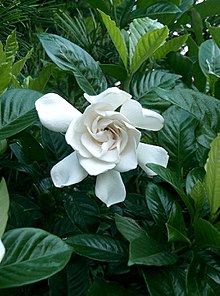Gardenia jasminoides
| Gardenia jasminoides | |
|---|---|
 |
|
| Scientific classification | |
| Kingdom: | Plantae |
| (unranked): | Angiosperms |
| (unranked): | Eudicots |
| (unranked): | Asterids |
| Order: | Gentianales |
| Family: | Rubiaceae |
| Genus: | Gardenia |
| Species: | G. jasminoides |
| Binomial name | |
|
Gardenia jasminoides J.Ellis |
|
| Synonyms | |
|
|
Gardenia jasminoides, (gardenia,cape jasmine,cape jessamine,danh-danh, or jasmin) is an evergreen flowering plant of the family Rubiaceae. It originated in Asia and is most commonly found growing wild in Vietnam, Southern China, Taiwan, Japan, Myanmar, and India. With its shiny green leaves and heavily fragrant white summer flowers, it is widely used in gardens in warm temperate and subtropical climates, and as a houseplant in temperate regions. It has been in cultivation in China for at least a thousand years, and was introduced to English gardens in the mid 18th century. Many varieties have been bred for horticulture, with low growing, and large-and long-flowering forms.
Gardenia jasminoides was described by English botanist John Ellis in 1761, after it had been conveyed to England in the 1750s. It gained its association with the name jasmine as the botanist and artist Georg Dionysius Ehret had depicted it and queried whether it was a jasmine as the flowers resembled the latter plant. The name stuck and lived on as common name and scientific epithet. The name G. augusta of Linnaeus has been ruled invalid.
The common names cape jasmine and cape jessamine derive from the earlier belief that the flower originated in Cape of Good Hope, South Africa.
Gardenia jasminoides is a shrub with greyish bark and dark green shiny evergreen leaves with prominent veins. The white flowers bloom in spring and summer and are highly fragrant. They are followed by small oval fruit.
Evidence of Gardenia jasminoides in cultivation in China dates to the Song Dynasty (960-1279 AD), where both wild and double-flowered forms have been depicted in paintings, such as those of the Song Emperor Huizong, and the Tenth century artist Xu Xi. The Yuan Dynasty (1271–1368) saw it on lacquerware, and the Ming Dynasty on porcelain (1368–1644). Gardenias were seen in nurseries in Guangzhou in 1794 by English statesman Sir John Barrow.
...
Wikipedia
